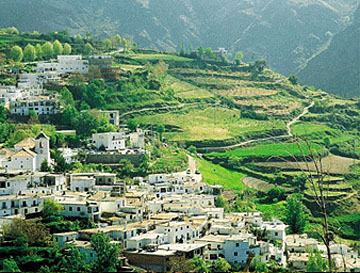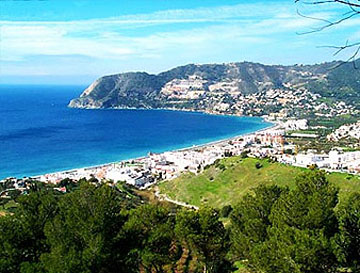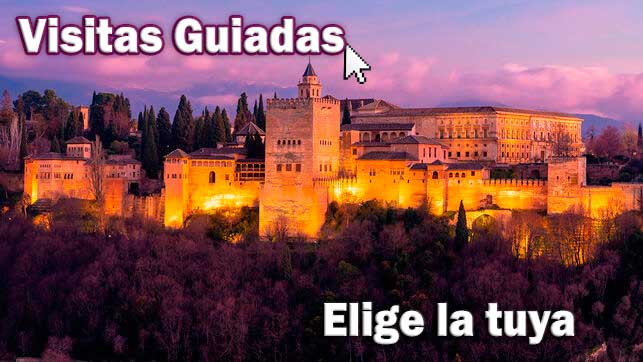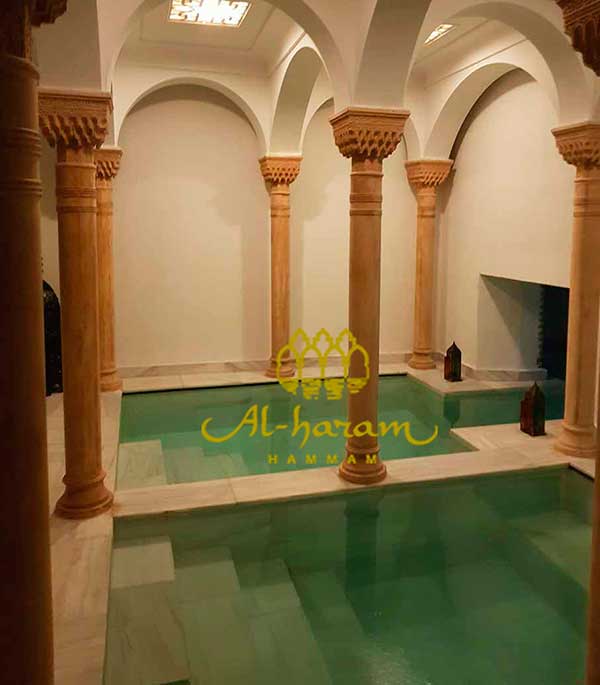- Home
- Granada Guide
- Province of Granada
La Alpujarra Granadina - Day trip
 JOIN A GROUP.
JOIN A GROUP.
Almost every Saturday during the whole year, we offer you a unique experience to discover just in one day this impresive Granadian corner, just at the back of the snow covered mountains of Sierra Nevada. We´ll drive you from the fertile plain of Granada to the mountains, crossing fields of vegetable gardens and orchards to the valleys of the Alpujarras.
Location
The Alpujarra is one of the most beautiful, wild and original regions in the world. It lies on the south side of the Sierra Nevada, which descends roughly from the maximum heights in the Iberian Peninsula to the Guadalfeo River valley. Within a few kilometres the Sierra de Lújar and the Contraviesa rise up again to fall later into the Mediterranean Sea, where the Costa Tropical shows its beaches and sunshine. The Alpujarra villages cling onto the mountainsides dispersing the white of the houses among the green of the forests and valleys. It is possible to study comparative botany in the richness of climates and altitudes occurring vertiginously on a slope of 3,000 metres within a linear distance of 30 kilometres.
History
Although both the Phoenicians and Romans passed through this region, the distinct personality of the Alpujarra comes from the 800 years of Arabic culture. The name of the region, the architecture, the irrigation system, the gastronomy and the character of its people, all stem from those times.
When the 'Nazarí' Kingdom of Granada surrendered to the Catholic Monarchs, many of its inhabitants took refuge in the Alpujarra Mountains and continued practicing their customs, religion and language for almost eighty years. They were the 'Moriscos' from Granada who remained in these craggy mountains until Don Juan de Austria, sent by King Philip II of Spain, ended with the violent rebellion which was tooking place and almost destorying the memories from a thousand-year-old civilisation.
The subsequent total depopulation made it necessary to repopulate the region with Castilian and Galician inhabitants. It is said that the names of many villages (for example, Capileira and Pampaneira) have Galician origin, but as their existence is previous to the Christian rule, this claim seems to be refuted. It is possible, however, that the ending "eira" comes from the Basque "herría" meaning house and that these names were created by Basque fugitives fleeing from their land under Roman rule.
Tropical Coast. A paradise by the Mediterranean Sea
 JOIN A GROUP.
Almost every Thursday and Saturday during the whole year, this one-day let you meet this peculiar and exotic corner between the Mediterranean Sea and the snow covered mountains of Sierra Nevada. These geografic characteristics make this region enjoy a microclimate with 320 sunny days in the year.
JOIN A GROUP.
Almost every Thursday and Saturday during the whole year, this one-day let you meet this peculiar and exotic corner between the Mediterranean Sea and the snow covered mountains of Sierra Nevada. These geografic characteristics make this region enjoy a microclimate with 320 sunny days in the year.
More than 320 sunny days each year and an average annual temperature of 20º Celsius turn Granada's Tropical Coast into a heavenly enclave. Light winds from North Africa, warm waters from the Mediterranean Sea and shelter provided by the nearby peaks of the Sierra Nevada give the Tropical Coast an Europe's unique subtropical microclimate.
Its three main tourist destinations are Almuñécar, Motril and Salobreña. Especially in summer their long beaches with thick sand and clean waters, awarded with a whole range of Blue Flags every year, welcome thousands of Spanish visitors and to a lesser extend foreigners too. However, they do not suffer from overcrowding affecting other Spanish seaside resorts.
Do you have any doubt? Call us
+34 958 91 80 29 From Monday to Friday 9.00 - 14.00 and 17.00 - 20.00Other Recommended Services
Choose your service




